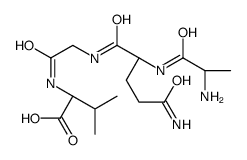EA-230
Modify Date: 2025-08-26 18:57:49

EA-230 structure
|
Common Name | EA-230 | ||
|---|---|---|---|---|
| CAS Number | 503844-09-5 | Molecular Weight | 373.40500 | |
| Density | N/A | Boiling Point | N/A | |
| Molecular Formula | C15H27N5O6 | Melting Point | N/A | |
| MSDS | N/A | Flash Point | N/A | |
Use of EA-230EA-230 is a synthetic oligopeptide originally derived from beta-human chorionic gonadotropin (beta-hCG) lysates. EA-230 has anti-inflammatory effects and can be used for the research of sepsis[1]. |
| Name | (2S)-2-[[2-[[(2S)-5-amino-2-[[(2S)-2-aminopropanoyl]amino]-5-oxopentanoyl]amino]acetyl]amino]-3-methylbutanoic acid |
|---|---|
| Synonym | More Synonyms |
| Description | EA-230 is a synthetic oligopeptide originally derived from beta-human chorionic gonadotropin (beta-hCG) lysates. EA-230 has anti-inflammatory effects and can be used for the research of sepsis[1]. |
|---|---|
| Related Catalog | |
| In Vivo | EA-230 (30-50 mg/kg; i.p.; twice daily for four consecutive days) improves survival and attenuate loss of kidney function in a mouse model of renal ischemia/reperfusion injury (IRI) and ischemia-induced delayed graft function after allogenic kidney transplantation[1]. Animal Model: Male C57Bl/6 mice, ischemia reperfusion injury model[1] Dosage: 20, 30, 40 or 50 mg/kg Administration: Intraperitoneal injection, twice daily for four consecutive days Result: Improved survival markedly. With doses between 30–50 mg/kg survival reached 56–62%, the low dose treatment with 20 mg/kg did not have a beneficial effect. Significantly increased renal blood flow (RBF), attenuated CTGF up-regulation, enhanced tubular epithelial cell regeneration and attenuated TGF-beta activation. |
| References |
| Molecular Formula | C15H27N5O6 |
|---|---|
| Molecular Weight | 373.40500 |
| Exact Mass | 373.19600 |
| PSA | 205.17000 |
| LogP | 1.79640 |
| InChIKey | DXRXYJYFADHAPA-AUTRQRHGSA-N |
| SMILES | CC(N)C(=O)NC(CCC(N)=O)C(=O)NCC(=O)NC(C(=O)O)C(C)C |
| L-Valine,L-alanyl-L-glutaminylglycyl |